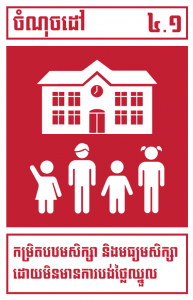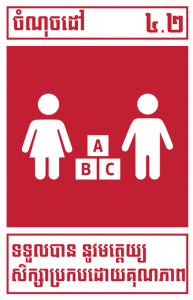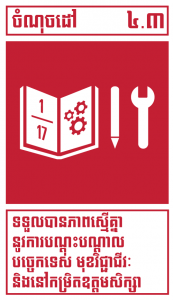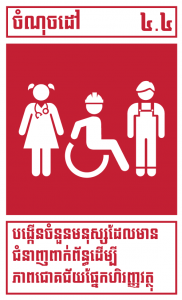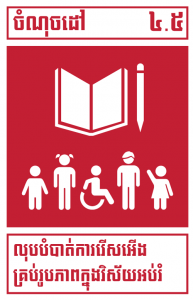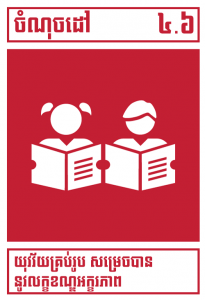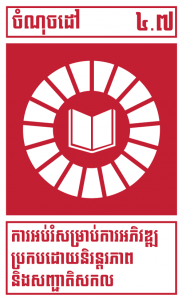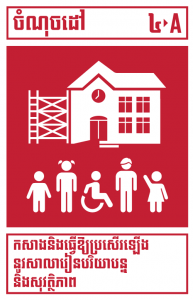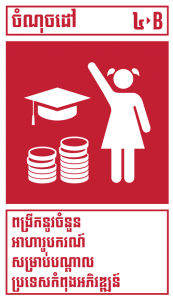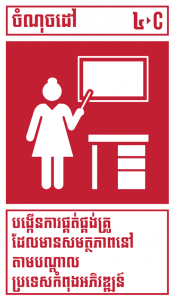គោលដៅអភិវឌ្ឍប្រកបដោយចរីភាពទី៤ គឺធានាការអប់រំប្រកបដោយ គុណភាព បរិយាបន្ន និងសមធម៌ និងលើកកម្ពស់កាលានុវត្តភាពសិក្សាពេញមួយជីវិតសម្រាប់ប្រជាជនគ្រប់រូប។1 ការអប់រំ គាំទ្រសមិទ្ធផលសមភាពយេនឌ័រតាមរយៈការផ្តល់សិទ្ធិអំណាចដល់ស្ត្រី វាក៏មានសារៈសំខាន់ក្នុងការបង្កើតភាពធន់នៃបរិស្ថាននៅក្នុងសង្គមមួយដែលមានភាពរួមបញ្ចូល។2 គោលដៅអភិវឌ្ឍប្រកបដោយចរីភាពទី៤ មានចំណុចដៅទូទៅចំនួន ៧ និង គោលដៅអនុវត្ត ចំនួន៣ និងសូចនាករ ចំនួន១១។3
គោលបំណងនៃគោលដៅនេះ គឺពឹងផ្អែកលើការចាប់យកជំនាញ និងការកសាងសមត្ថភាពដើម្បីទទួលបាននូវចំណេះដឹងដែលកម្ពុជា និងប្រជាជនកម្ពុជាត្រូវការ។ ការអប់រំអាចនាំមកនូវការច្នៃប្រឌិត និងការបង្កើនកម្រិតផលិតភាព ហើយជាចុងក្រោយផ្តល់ផលប្រយោជន៍ដូចជា ធ្វើឲ្យស្ថានភាពសេដ្ឋកិច្ចប្រសើរជាងមុន។4
ស្ថាប័នឯកជន ក៏អាចរួមចំណែកដល់ការសម្រចបាននូវគោលដៅអភិវឌ្ឍប្រកបដោយចរីភាពផងដែរ តាមរយៈការចូលរួមជាមួយរដ្ឋាភិបាល និងសង្គមស៊ីវិលដើម្បីគាំទ្រដល់គុណភាពនៃការអប់រំនៅក្នុងតំបន់របស់ពួកគេ។5
ការផ្លាស់ប្តូរពីគោលដៅអភិវឌ្ឍន៍សហស្សវត្សរ៍ ទៅជាគោលដៅអភិវឌ្ឍប្រកបដោយចីរភាពទី៤ នៅក្នុងប្រទេសកម្ពុជា
គោលដៅអភិវឌ្ឍន៍សហស្សវត្សរ៍ (គ.អ.ស.ក) ដែលបានដំណើរការពីឆ្នាំ ២០០២ ដល់ឆ្នាំ ២០១៥ ត្រូវបានគាំទ្រយ៉ាងខ្លាំងដោយកម្ពុជា ហើយកម្ពុជាបានបង្កើតគោលដៅអភិវឌ្ឍន៍សហស្សវត្សរ៍របស់ខ្លួន ចំនួន៩ ក្នុងឆ្នាំ ២០០៣។6
គោលដៅមួយក្នុងចំណោមគោលដៅទាំង៩នោះ គឺ គោលដៅអភិវឌ្ឍសហស្សវត្សន៍កម្ពុជាទី២ ដែលគ្រោង សម្រេចឲ្យបានសកលកម្មអក្ខរកម្មនិងការអប់រំបឋមសិក្សា។
តារាងខាងក្រោមបង្ហាញថាប្រទេសកម្ពុជាមានការរីកចម្រើនគួរឱ្យកត់សម្គាល់ក្នុងរយៈពេលនោះ៖
ការអនុវត្តគោលដៅអភិវឌ្ឍន៍សហស្សវត្សរ៍កម្ពុជាទី២- សម្រេចឲ្យបានសកលកម្មអក្ខរកម្មនិងការអប់រំបឋមសិក្សា7
| ចំណុចដៅ/សូចនាករ | សមិទ្ធផល | |||||
| ឯកតា | ២០០០ | ២០០៥ | ២០១០ | ២០១៥ ជាក់ស្តែង | ២០១៥ ចំណុចដៅ | |
| (2A) សម្រេចឲ្យបាន ១០០% ការសិក្សាពិតនៅកម្រិតបឋមសិក្សា | ||||||
| អាត្រាអក្ខរកម្មក្នុងចំណោមប្រជាជនអាយុ ១៥-២៤ឆ្នាំ ពីឆ្នាំ២០០៤ ដល់ឆ្នាំ២០១៣ | % | ៨០,៤ | ៨៨,៨ | ៩៣,០ | ៩៤,៥ | |
| (2B) សម្រេចឲ្យបាន ១០០% អាត្រាបញ្ចប់ការសិក្សាពិតនៅកម្រិតបឋមសិក្សា | ||||||
| អាត្រាពិតនៃការសិក្សានៅកម្រិតបឋមសិក្សា | % | ៨៥,០ (២០១១) | ៧៦,៦ | ៨៥,៦ | ៩៧,៩(២០១៤/២០១៥) | ១០០ |
| (2C) សម្រេចឲ្យបានសកលកម្មអក្ខរកម្ម ក្នុងចំណោមប្រជាជនអាយុពី ១៥ – ២៥ឆ្នាំ | ||||||
| អាត្រារួមនៃការសិក្សានៅតាមកម្រិតមធ្យមសិក្សាបឋមភូមិ | % | ៤៥,៨ | ៥៨,១ | ៥៥,១ | ៧៤ | |
| អត្រាបញ្ចប់ការសិក្សានៅកម្រិតបឋមសិក្សា | % | ៥១ (២០០១) | ៤៦,៨ | ៨៣,២ | ៨៤,១ | ១០០ |
| អាត្រាបញ្ចប់ការសិក្សានៅកម្រិតមធ្យមសិក្សាបឋមភូមិ | % | ១៩,៧ | ៤៨,៧ | ៤០,៣ | ១០០ | |
| (2D) សម្រចឲ្យបាននូវសមភាពយេនឌ័រនៅកម្រិតបឋមសិក្សា | ||||||
| សន្ទស្សន៍៍យេនឌ័រនៅកម្រិតបឋមសិក្សា | Ratio | ០,៩៥ | ០,៩៧ | ០,៩១ | ១ | ១ |
| សន្ទស្សន៍៍យេនឌ័រនៅកម្រិតមធ្យមសិក្សាបឋមភូមិ | Ratio | ០,៦៨ | ០,៧៩ | ០,៩៧ | ១,១ | ១ |
គោលដៅអភិវឌ្ឍន៍សហស្សវត្សរ៍កម្ពុជាទី៣ គឺ លើកកម្ពស់សមភាពយេនឌ័រនិងការផ្តល់សិទ្ធិអំណាចដល់ស្ត្រី។ វាក៏មានសមាសភាគអប់រំសំខាន់ផងដែរ។ ជាថ្មីម្តងទៀត ប្រទេសកម្ពុជាបានបោះជំហានទៅមុខយ៉ាងលឿន។
ការអនុវត្តគោលដៅអភិវឌ្ឍន៍សហស្សវត្សរ៍កម្ពុជាទី៣ គឺ ការលើកកម្ពស់សមភាពយេនឌ័រនិងការផ្តល់សិទ្ធិអំណាចដល់ស្ត្រី។8
| (3A) សម្រេចឲ្យបានសមភាពយេនឌ័រក្នុងវិស័យអប់រំ និងអក្ខរកម្ម | |||||||
| ល.រ | សូចនាករ | សមិទ្ធផល | |||||
| ឯកតា | ២០០០ | ២០០៥ | ២០១០ | ២០១៥ ជាក់ស្តែង | ២០១៥ ចំណុចដៅ | ||
| 1 | អាត្រាភេទ (ស្រ្តី/ប្រុស) នៅកម្រិតមធ្យមសិក្សាទុតិយភូមិ | % | ៤៨ (២០០១) | ៦០ | ៨២ | ១០០ | ១០០ |
| 2 | អាត្រាភេទ (ស្រ្តី/ប្រុស) នៅកម្រិតឧត្តមសិក្សា | % | ៣៨ (២០០១) | ៤៥,៦ | ៨៦,៧ | ៨៥ | ៨៥ |
| 3 | អាត្រាភេទ (ស្រ្តី/ប្រុស) អាយុ ១៥-២៤ឆ្នាំ នៃអក្ខរកម្ម | % | ៨៧ (១៩៨៩) | ៩០ | ៩៨,៣ | ១០០ | ១០០ |
| 4 | អាត្រាភេទ (ស្រ្តី/ប្រុស) អាយុ ២៥-៤៤ឆ្នាំ នៃអក្ខរកម្ម | % | ៧៨ (១៩៩៨) | ៨០ | ៩៩ | ១០០ | ១០០ |
វិធានការផ្សេងៗទៀតគាំទ្រដល់នៃការកែលម្អប្រព័ន្ធអប់រំក្នុងរូបភាពផ្សេងៗ ក្នុងកំឡុងឆ្នាំកន្លងទៅនៃគោលដៅអភិវឌ្ឍន៍សហស្សវត្សរ៍។ និន្នាការសន្ទស្សន៍អភិវឌ្ឍន៍មនុស្សនៃកម្ពុជា9បង្ហាញថា ឆ្នាំនៃការសិក្សាមធ្យមមានការកើនឡើង ២ ឆ្នាំ រវាងឆ្នាំ ១៩៩០ និង ២០១៧ បើទោះជាឆ្នាំនៃការសិក្សាដែលរំពឺងបានកើនឡើងច្រើនជាងនេះទៀត៖
| ឆ្នាំសិក្សាដែលរំពឹងទុក | ចំនួនឆ្នាំសិក្សាមធ្យម | |
| ១៩៩០ | ៦,៧ | ២,៧ |
| ១៩៩៥ | ៧,១ | ៣,០ |
| ២០០០ | ៧,៦ | ៣,២ |
| ២០០៥ | ១០,២ | ៣,៥ |
| ២០១០ | ១១,០ | ៤,៤ |
| ២០១៥ | ១១,៧ | ៤,៧ |
| ២០១៦ | ១១,៧ | ៤,៧ |
| ២០១៧ | ១១,៧ | ៤,៨ |
តួលេខទាំងនេះគ្របដណ្ដប់គម្លាតយេនឌ័រ ជាពិសេសសម្រាប់ឆ្នាំសិក្សាមធ្យម ដែលក្នុងឆ្នាំ ២០១៧ មាន ៥,៦ សម្រាប់បុរស ប៉ុន្តែមានត្រឹមតែ ៣,៨ សម្រាប់ស្ត្រីប៉ុណ្ណោះ។10
តួលេខរបស់កម្មវិធីអភិវឌ្ឍន៍អង្គការសហប្រជាជាតិ (UNDP) បង្ហាញពីភាពខុសគ្នាដ៏ធំមួយ នៅពេលដែលសង្គមទាំងមូលត្រូវបានគេយកមកពិចារណា។ ខណៈដែលប្រជាជនបុរសចំនួន ២៨% មានចំណេះដឹងយ៉ាងហោចណាស់កម្រិតថ្នាក់អនុវិទ្យាល័យ តួលេខរបស់ស្ត្រី គឺមានចំនួនតិចជាងពាក់កណ្តាលនៃចំនួនបុរស ពោលគឺ ១៥% ។11
ការជំរុញកិច្ចការងារទាំងឡាយដើម្បីកែលម្អការអប់រំនៅកម្ពុជាគឺដោយរដ្ឋធម្មនុញ្ញ។12 មាត្រាទី ៦៥ ផ្តល់សិទ្ធិឲ្យប្រជាពលរដ្ឋទទួលបានការអប់រំគុណភាពគ្រប់កម្រិត។ មាត្រាទី ៦៦ ផ្តោតលើការទទួលខុសត្រូវរបស់រដ្ឋក្នុងការបង្កើតប្រព័ន្ធអប់រំដែលមានលក្ខណៈទូលំទូលាយនិងមានស្តង់ដារទូទាំងប្រទេស ជាមួយ (ក្នុងមាត្រា ៦៧) វិធីសាស្ត្របង្រៀនបែបទំនើប។ មាត្រាទី ៦៨ តម្រូវឱ្យរដ្ឋផ្តល់ការអប់រំបឋមសិក្សានិងមធ្យមសិក្សាដោយឥតគិតថ្លៃ ដល់ប្រជាពលរដ្ឋទាំងអស់នៅតាមសាលារដ្ឋ។ ប្រជាពលរដ្ឋមានសិទ្ធិទទួលបានការអប់រំយ៉ាងតិច ៩ឆ្នាំ។
ដើម្បីសម្រេចបានតាមតម្រូវការរដ្ឋធម្មនុញ្ញ និងគោលដៅអភិវឌ្ឍន៍សហស្សវត្សរ៍ គំនិតផ្តួចផ្តើមគោលនយោបាយសំខាន់ៗគឺ ផែនការយុទ្ធសាស្ត្រវិស័យអប់រំ កម្មវិធីគាំទ្រវិស័យអប់រំ (ESSP) និងផែនការអប់រំសម្រាប់ទាំងអស់គ្នា (EFA) ។13
ក្របខ័ណ្ឌច្បាប់ដើម្បីផ្តល់ការអប់រំមានគុណភាពលក្ខណៈស្តង់ដារ ត្រូវបានកំណត់ដោយផែនការនិងគោលនយោបាយសកម្មភាពដូចខាងក្រោម14៖
- ផែនការយុទ្ធសាស្ត្រវិស័យអប់រំ ឆ្នាំ ២០១៤ – ២០១៨
- ច្បាប់ ស្ដីពី ការអប់រំ
- គោលនយោបាយសាលារៀនកុមារ ២០០៧
- គោលនយោបាយស្តីពីការអប់រំកុមារពិការ ២០០៨
- គោលនយោបាយថ្នាក់ជាតិស្តីពីការគាំពារនិងអភិវឌ្ឍន៍កុមារតូច
- ស្តង់ដាររបស់បណ្ណាល័យនៅក្នុងបឋមសិក្សា ២០១១
- គោលនយោបាយស្តីពីគ្រូបង្រៀន ២០១៣
- គោលនយោបាយស្តីពីគ្រូបង្រៀន ផែនការសកម្មភាព ២០១៥
- គោលនយោបាយស្តីពីការការពារកុមារនៅក្នុងសាលារៀន ២០១៦
- ផែនការគោលសម្រាប់អភិវឌ្ឍការស្រាវជ្រាវក្នុងការអប់រំ ២០១១-២០១៥
- គោលនយោបាយស្តីពីការអភិវឌ្ឍការស្រាវជ្រាវក្នុងវិស័យអប់រំ
- ផែនការគោលបច្ចេកវិទ្យាព័ត៌មាន និងសារគមនាគមន៍ ក្នុងវិស័យអប់រំ
- គោលនយោបាយ ស្ដីពី ចក្ខុវិស័យឧត្ដមសិក្សា ២០៣០
ការធ្វើមូលដ្ឋានីយកម្មគោលដៅទី៤នៅក្នុងប្រទេសកម្ពុជា
ក្នុងចំណោមចំណុចដៅសកលទាំង ១០ សម្រាប់ការអប់រំប្រកបដោយគុណភាព កម្ពុជាបានរើសយកចំណុចចំនួន ៧ ដែលធ្វើអោយវាជាគោលដៅមួយក្នុងចំណោមគោលដៅជាច្រើនទៀតដែលត្រូវបានអនុម័តយា៉ងទូលំទូលាយបំផុតក្នុងគោលដៅអភិវឌ្ឍប្រកបដោយចីរភាពកម្ពុជា។ ចំនួនសូចនាករកាន់តែមានច្រើនទៀតសម្រាប់គោលដៅមួយនេះ។ ប្រទេសកម្ពុជាបានកំណត់សូចនាករចំនួន ១៨ ខណៈដែលក្របខ័ណ្ឌគោលដៅអភិវឌ្ឍនប្រកបដោយចីរភាពសកលមានតែ១១។
គោលដៅអភិវឌ្ឍប្រកបដោយចីរភាពកម្ពុជា ត្រូវបានប្រកាសនៅចុងឆ្នាំ ២០១៨។15
ប្រទេសកម្ពុជាបានរើសយកគោលដៅអភិវឌ្ឍន៍សហស្សវត្សរ៍កម្ពុជាមួយចំនួនដែលមិនទាន់បានបញ្ចប់ ដូចជា អត្រាបញ្ចប់បឋមសិក្សា ហើយក៏បានបន្ថែមគោលដៅថ្មីៗ នៅជុំវិញលទ្ធភាពទទួលបានការអប់រំចាប់តាំងពីកុមារភាព និងកម្រិតឧត្តមសិក្សា។
មធ្យោបាយនៃការអនុវត្តគោលដៅអភិវឌ្ឍប្រកបដោយចីរភាពទី៤ នៅក្នុងប្រទេសកម្ពុជា
គោលដៅអនុវត្តចំនួនពីរដែលកម្ពុជាបានជ្រើសយកគឺ៖
៤.a កសាងនិងធ្វើឱ្យប្រសើរឡើងនូវសម្ភារៈបរិក្ខារអប់រំ ដែលធ្វើឲ្យមានភាពប្រែប្រួលដល់កុមារ អ្នកបាត់បង់សមត្ថភាពពលកម្មនិងយែនឌ័រ និងផ្តល់នូវសុវត្ថិភាព គ្មានអំពើហិង្សា មានបរិស្ថាននៃការសិក្សាប្រកបដោយបរិយាបន្ននិងប្រសិទ្ធិភាពសម្រាប់ប្រជាជនគ្រប់រូប។
៤.c បង្កើនឲ្យបានច្រើននូវការផ្គត់ផ្គង់គ្រូបង្រៀនដែលមានគុណភាព រូមទាំង តាមរយៈកិច្ចសហប្រតិបត្តិការអន្តរជាតិ សម្រាប់ការបណ្តុះបណ្តាលគ្រូបង្រៀននៅក្នុងប្រទេសកម្ពុជា។
ប្រទេសកម្ពុជាមិនមាននិន្នាការទទួលយកចំណុចដៅដែលខ្លួនយល់ថាមិនស្ថិតនៅក្នុងការគ្រប់គ្រងរបស់ខ្លួនទេ ដូច្នេះចំណុចដៅនៃការអនុវត្តគោលដៅអភិវឌ្ឍប្រកបដោយចីរភាពនៃការពង្រីកចំនួនអាហារូបករណ៍ សម្រាប់ប្រជាជននៃបណ្តាប្រទេសដែលមានការអភិវឌ្ឍនតិចតួច មិនមាននៅក្នុងគោលដៅអភិវឌ្ឍប្រកបដោយចីរភាពកម្ពុជា ទេ ។
ដោយមានកិច្ចសហការជាមួយភ្នាក់ងាររដ្ឋាភិបាលនានា ដូចជា អង្គការយូណេស្កូ អង្គការក្រៅរដ្ឋាភិបាល និងដៃគូពាក់ព័ន្ធផ្សេងៗទៀត ក្រសួងការងារនិងបណ្តុះបណ្តាលវិជ្ជាជីវៈ និងក្រសួងអប់រំ យុវជន និងកីឡា (MoEYS) បានរួមគ្នាបង្កើតគំនិតផ្តួចផ្តើមជាច្រើនក្នុងវិស័យអប់រំ។ គំនិតផ្តួចផ្តើមទាំងនោះរួមមាន ការកែលម្អគុណភាពការអប់រំ ការដំឡើងប្រាក់ខែនិងលក្ខខណ្ឌការងារផ្សេងៗសម្រាប់គ្រូបង្រៀន
ការបំពេញកំណែទម្រង់លើកម្មវិធីបណ្តុះបណ្តាលវិជ្ជាជីវៈ និងប្រព័ន្ធវាយតម្លៃ។16
គំនិតផ្តួចផ្តើមដូចជា”BEEP” ដែលជាកម្មវិធីបច្ចេកវិទ្យាព័ត៌មាននិងសារគមនាគមន៍ សម្រាប់ការអប់រំមូលដ្ឋានសមមូល គឺជាឧទាហរណ៍មួយនៃលទ្ធផលរបស់កិច្ចសហប្រតិបត្តិការរវាងក្រសួងអប់រំយុវជននិងកីឡា ជាមួយស្ថាប័នដទៃទៀត។
សម្រាប់ការកែលម្អររសម្ភារៈបរិក្ខារអប់រំ ក្រសួងអប់រំ យុវជន និងកីឡានឹងសហការជាមួយក្រសួងអភិវឌ្ឍន៍ជនបទ (MRD)។17
គោលនយោបាយអភិវឌ្ឍន៍ឧស្សាហកម្មកម្ពុជា ទទួលស្គាល់ពីសារៈសំខាន់នៃការអភិវឌ្ឍចំណេះដឹងនិងជំនាញបច្ចេកទេសនៅក្នុងកម្លាំងពលកម្មការងារ។18
នៅក្នុងខែមេសា ឆ្នាំ២០១៤ ក្រសួងអប់រំ យុវជន និងកីឡាបានបោះពុម្ពផ្សាយនូវគោលនយោបាយស្តីពីចក្ខុវិស័យឧត្តមសិក្សាឆ្នាំ ២០៣០ ដែលឆ្លុះបញ្ចាំងពីចក្ខុវិស័យនិងការភ្ជាប់នូវចំណុចដៅសម្រាប់ការអនុវត្តគោលដៅអភិវឌ្ឍប្រកបដោយចីរភាព ទី៤។19
ការត្រួតពិនិត្យគោលដៅអភិវឌ្ឍប្រកបដោយចីរភាពទី៤ នៅក្នុងប្រទេសកម្ពុជា
នៅកម្ពុជា ការគ្រប់គ្រងទិន្នន័យអប់រំ គឺស្ថិតក្រោមនាយកដ្ឋានអប់រំក្រៅប្រព័ន្ធនៃក្រសួងអប់រំយុវជននិងកីឡា (NFE-MIS)ក្រសួងការងារនិងបណ្តុះបណ្តាលវិជ្ជាជីវៈ (TVET-MIS) និងវិទ្យាស្ថានជាតិស្ថិតិ (NIS) របស់ក្រសួងផែនការ (MoP)។20
ទីភ្នាក់ងារដែលទទួលបន្ទុកការត្រួតពិនិត្យនិងវាយតម្លៃចំណុចដៅ និងសូចនាកររបស់គោលដៅអភិវឌ្ឍប្រកបដោយចីរភាពកម្ពុជា ទី៤ គឺ ក្រសួង អប់រំ យុវជន និងកីឡា។ ក្នុងករណីខ្លះ ក្រសួងអប់រំ យុវជន និងកីឡា នឹងសហការជាមួយភ្នាក់ងាររដ្ឋាភិបាលដទៃទៀត។21
ចំណុចដៅ ៤,៣ (តុល្យភាពយេនឌ័រនៃការចុះឈ្មោះចូលរៀនថ្នាក់ឧត្តមសិក្សា) នឹងត្រូវត្រួតពិនិត្យដោយក្រសួងអប់រំ យុវជន និងកីឡា និង ក្រសួងវប្បធម៌និងវិចិត្រសិល្បៈ (MCFA)។
ក្នុងករណី ចំណុចដៅទី ៤.a (ការកសាងនិងលើកកម្ពស់សម្ភារៈបរិក្ខារអប់រំ) ក្រសួងអប់រំ យុវជន និងកីឡា និងក្រសួងអភិវឌ្ឍន៍ជនបទ(MRD)
ជាក្រសួងដែលពាក់ព័ន្ធ។22
ប្រធានបទពាក់ព័ន្ធ
ឯកសារយោង
- 1. វេទិការចំណេះដឹងស្តីពីគោលដៅអភិវឌ្ឍប្រកបដោយចីរភាព ឆ្នាំ២០១៨។ “គោលដៅអភិវឌ្ឍប្រកបដោយចីរភាពទី៤”។ ចូលអានថ្ងៃទី ១៥ ខែ មីនា ឆ្នាំ២០១៩។
- 2. ត្រីវិស័យនៃគោលដៅអភិវឌ្ឍប្រកបដោយចីរភាព ឆ្នាំ២០១៥។ “គោលដៅអភិវឌ្ឍប្រកបដោយចីរភាពទី៤”។ ចូលអានថ្ងៃទី ១៥ ខែ មីនា ឆ្នាំ២០១៩។
- 3. វេទិការចំណេះដឹងស្តីពីគោលដៅអភិវឌ្ឍប្រកបដោយចីរភាព ឆ្នាំ២០១៨។ “គោលដៅអភិវឌ្ឍប្រកបដោយចីរភាពទី៤”។ ចូលអានថ្ងៃទី ១៥ ខែ មីនា ឆ្នាំ២០១៩។
- 4. ត្រីវិស័យនៃគោលដៅអភិវឌ្ឍប្រកបដោយចីរភាព ឆ្នាំ២០១៥។ “គោលដៅអភិវឌ្ឍប្រកបដោយចីរភាពទី៤”។ ចូលអានថ្ងៃទី ១៥ ខែ មីនា ឆ្នាំ២០១៩។
- 5. ដូចឯកសារយោងខាងលើ
- 6. រាជរដ្ឋាភិបាលកម្ពុជា ឆ្នាំ២០១៨ ។ “គោលដៅអភិវឌ្ឍកម្ពុជាប្រកបដោយចីរភាពកម្ពុជា ២០១៦-២០៣០“។ ចូលអានថ្ងៃទី ៣០ ខែ មីនា ឆ្នាំ២០១៩។
- 7. ដូចឯកសារយោងខាងលើ
- 8. ដូចឯកសារយោងខាងលើ
- 9. កម្មវិធីអភិវឌ្ឍន៍អង្គការសហប្រជាជាតិ ឆ្នាំ២០១៨។ “សន្ទស្សន៍និងសូចនាករនៃការអភិវឌ្ឍមនុស្ស៖ បច្ចុប្បន្នភាពសិ្ថតិ ឆ្នាំ២០១៨“។ ចូលអានថ្ងៃទី១៥ ខែមីនា ឆ្នាំ២០១៩។
- 10. ដូចឯកសារយោងខាងលើ
- 11. ដូចឯកសារយោងខាងលើ
- 12. រដ្ឋធម្មនុញ្ញនៃព្រះរាជាណាចក្រកម្ពុជា ឆ្នាំ១៩៩៣។ ចូលអានថ្ងៃទី២៩ ខែមីនា ឆ្នាំ២០១៩។
- 13. រាជរដ្ឋាភិបាលកម្ពុជា។ “គោលដៅអភិវឌ្ឍន៍សហស្សវត្សរ៍កម្ពុជា” ។ ចូលអានថ្ងៃទី១៥ ខែមីនា ឆ្នាំ២០១៩។
- 14. អង្គការទស្សនៈវិស័យពិភពលោក ២០១៧។ “ការអប់រំ - គោលនយោបាយសង្ខេបប្រទេសកម្ពុជា”។ ចូលអានថ្ងៃទី១៥ ខែមីនា ឆ្នាំ២០១៩។
- 15. រាជរដ្ឋាភិបាលកម្ពុជា ឆ្នាំ២០១៨។ “គោលដៅអភិវឌ្ឍន៍កម្ពុជាប្រកបដោយចីរភាពកម្ពុជា ២០១៦-២០៣០“។ ចូលអានថ្ងៃទី៣០ ខែមីនា ឆ្នាំ២០១៩។
- 16. កាសែតភ្នំពេញប៉ុស្តិ៍ ឆ្នាំ២០១៧។ “ចំណុចដៅអក្ខរកម្មនៃគោលដៅអភិវឌ្ឍប្រកបដោយចីរភាព”។ ចូលអានថ្ងៃទី១៥ ខែមីនា ឆ្នាំ២០១៩។
- 17. រាជរដ្ឋាភិបាលកម្ពុជា ឆ្នាំ២០១៨ ។ “គោលដៅអភិវឌ្ឍន៍កម្ពុជាប្រកបដោយចីរភាពកម្ពុជា ២០១៦-២០៣០“ ។ ចូលអានថ្ងៃទី១៥ ខែមីនា ឆ្នាំ២០១៩។
- 18. រាជរដ្ឋាភិបាលកម្ពុជា ឆ្នាំ២០១៥។ “គោលនយោបាយអភិវឌ្ឍន៍ឧស្សាហកម្មកម្ពុជា”។ ចូលអានថ្ងៃទី ១៥ ខែ មីនា ឆ្នាំ ២០១៩។
- 19. ព្រះរាជាណាចក្រកម្ពុជាជាតិសាសនាព្រះមហាក្សត្រ ឆ្នាំ២០១៤ ។ “គោលនយោបាយស្តីពីការអប់រំជាន់ខ្ពស់ យុវជន និងកីឡា”។ ចូលអានថ្ងៃទី១៥ ខែមីនា ឆ្នាំ២០១៩។
- 20. Pitin ២០១៧។ “ការត្រួតពិនិត្យគោលដៅទី៤អំពីការអប់រំ នៃគោលដៅអភិវឌ្ឍប្រកបដោយចីរភាព ឆ្នាំ២០៣០ ក្នុងប្រទេសកម្ពុជា”។ ចូលអានថ្ងៃទី១៥ ខែមីនា ឆ្នាំ២០១៩។
- 21. រាជរដ្ឋាភិបាលកម្ពុជា ឆ្នាំ២០១៨ ។ “គោលដៅអភិវឌ្ឍន៍កម្ពុជាប្រកបដោយចីរភាពកម្ពុជា ២០១៦-២០៣០“ ។ ចូលអានថ្ងៃទី១៥ ខែមីនា ឆ្នាំ២០១៩។
- 22. ដូចឯកសារយោងខាងលើ
